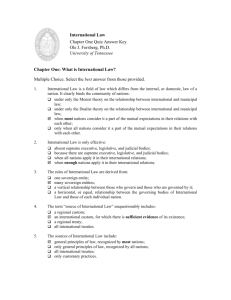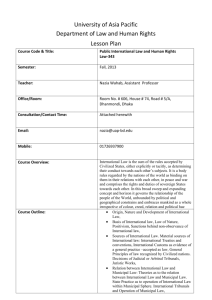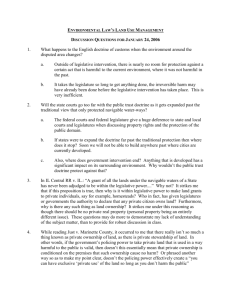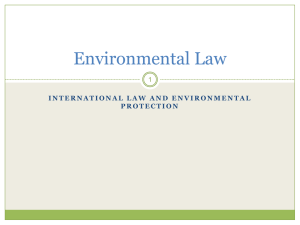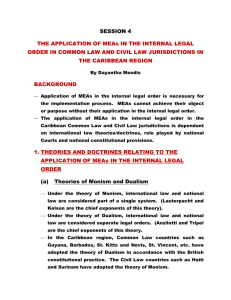Chapter 1: Test Bank
advertisement
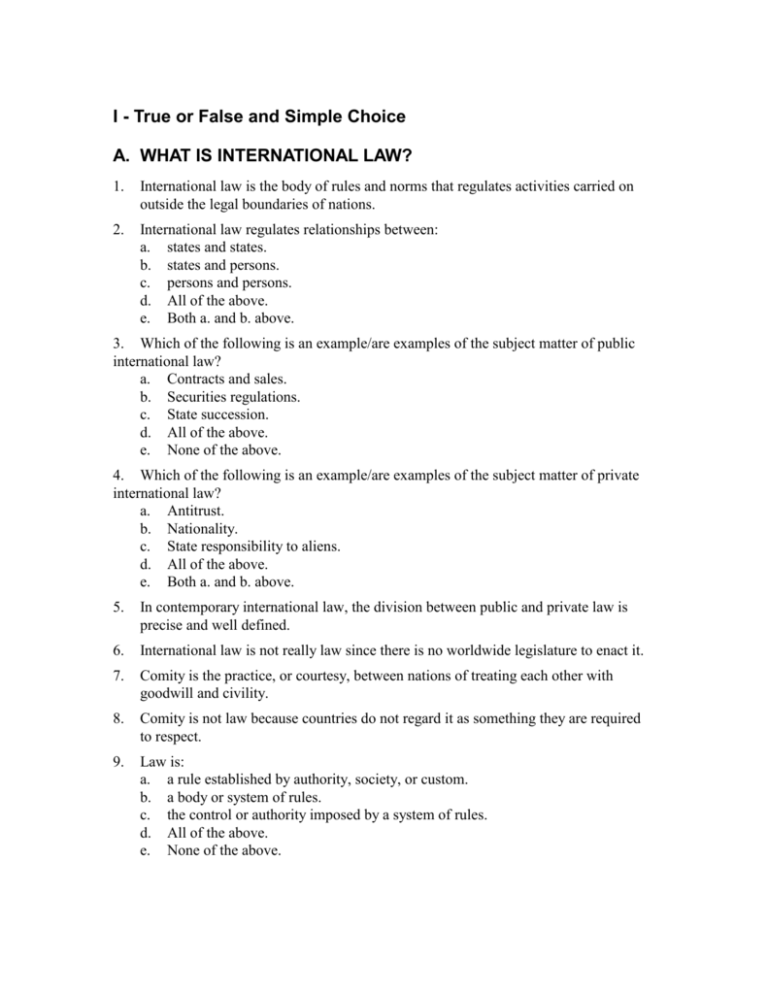
I - True or False and Simple Choice A. WHAT IS INTERNATIONAL LAW? 1. International law is the body of rules and norms that regulates activities carried on outside the legal boundaries of nations. 2. International law regulates relationships between: a. states and states. b. states and persons. c. persons and persons. d. All of the above. e. Both a. and b. above. 3. Which of the following is an example/are examples of the subject matter of public international law? a. Contracts and sales. b. Securities regulations. c. State succession. d. All of the above. e. None of the above. 4. Which of the following is an example/are examples of the subject matter of private international law? a. Antitrust. b. Nationality. c. State responsibility to aliens. d. All of the above. e. Both a. and b. above. 5. In contemporary international law, the division between public and private law is precise and well defined. 6. International law is not really law since there is no worldwide legislature to enact it. 7. Comity is the practice, or courtesy, between nations of treating each other with goodwill and civility. 8. Comity is not law because countries do not regard it as something they are required to respect. 9. Law is: a. a rule established by authority, society, or custom. b. a body or system of rules. c. the control or authority imposed by a system of rules. d. All of the above. e. None of the above. B. THE MAKING OF INTERNATIONAL LAW 10. Despite the lack of international law-making machinery, states function informally as both lobbyists and legislators. 11. International law exists when there is a consensus of the international community. 12. Evidence of the general consent of the international community to the existence of a rule of international law can be found in: a. decisions of the International Court of Justice. b. resolutions passed by the UN General Assembly. c. the conduct and practices of states in their dealings between themselves. d. All of the above. e. Both a. and c. 13. Unratified treaties and reports of international agencies are sometimes cited as evidence of a trend toward the development of a rule of international law. 14. Case law derived from the decisions of arbitration tribunals hearing disputes between private parties is never used as asource of international law rules. C. SOURCES OF INTERNATIONAL LAW 15. The sources of international law which Article 38(1) of the Statute of the International Court of Justice states that the court is permitted to use in settling disputes are: a. general principles of law. b. international conventions. c. the case law of municipal courts. d. All of the above. e. Both a. and b. above 16. In determining if a practice has become a rule of international customary law, Article 38(1) of the Statute of the International Court of Justice states that the court is permitted to look to: a. economic trends. b. historical records. c. teachings of legal writers. d. All of the above. e. Both a. and b. above. 17. Which of the following sources of international law does the International Court of Justice normally regard as the most authoritative? a. Customary international law. b. General principles of law. c. International conventions. d. Judicial decisions. e. Teachings of legal writers. 1. Treaties and Conventions 18. Treaties and conventions have binding effect because: a. one country fears that if it does not respect its promises, other countries will not respect their promises. b. states that fail to observe them may be fined or otherwise punished by the International Court of Justice. c. states that fail to observe them will lose their membership in the United Nations. d. All of the above. e. Both b. and c. above. 19. The customary rules that govern treaties are now codified in the Vienna Convention on the Law of Treaties. 20. The Vienna Convention on the Law of Treaties applies to treaties and conventions that: a. are governed by municipal law. b. are in writing. c. are made orally. d. relate to international organizations. e. All of the above. 2. Custom 21. Once adopted, customary rules of international law are seldom changed. 22. To establish the existence of a customary rule of international law, one must show: a. opinio juris et necessitatis. b. pacta sunt servanda. c. rebus sic standibus. d. waiver. e. None of the above. 23. To establish the existence of a customary rule of international law, one must show that the international community has observed the rule for a long period of time. 24. To establish the existence of a customary rule of international law, one must show that the entire international community has given its consent to the rule. 25. In The Lotus Case, Turkey had begun prosecution of the officers on a French ship who had been involved in a collision with a Turkish ship. France brought suit in the Permanent Court of International Justice (PCIJ) claiming that customary international law allowed only the state whose ship the officers were aboard to prosecute them. The PCIJ ruled against France because: a. in previous similar cases, the states which had acted as France suggested had not done so because they thought they were obliged to do so. b. the rule which France suggested had become custom had only been observed by a few states. c. the rule which France suggested had become custom had only been observed for a few years. d. e. All of the above were reasons given by the PCIJ. None of the above is a correct answer. 26. Which of the following states is not required to observe a particular rule of customary international law? a. A persistent objector. b. A state that has recently acquired its independence following the division of its predecessor state. c. A superpower. d. All of the above. e. Both a. and b. above. 3. General Principles 27. General principles of international law are based on legal rules that are common to both (or all) the state parties to a dispute. D. THE SCOPE OF INTERNATIONAL LAW IN ACTUAL PRACTICE 1. The Practice in International Tribunals 28. In international tribunals, municipal law is regarded as being correlative with international law. 29. International tribunals generally regard states as having an obligation to bring their municipal law into compliance with international norms. 30. In international tribunals, a. municipal laws are treated as “mere facts.” b. municipal laws will not be declared either void or valid. c. municipal laws will not be interpreted. d. the parties must prove what the municipal law is. e. All of the above. 2. The Practice in Municipal Courts 31. In municipal courts, international law is generally treated as being subservient. 32. Once a municipal court determines that a particular rule of international law is applicable in a particular case, that law will be treated as law and not as a fact. 33. When a municipal court acts to determine if a particular rule of international law has been received into the local jurisprudence, it will (in most countries) apply the doctrine of: a. immaculate conception. b. incorporation. c. resuscitation. d. transformation. e. vivification. 34. According to the doctrine of incorporation, customary international laws are treated as adopted by a municipal court to the extent that they are not inconsistent with prior municipal legislation or judicial decisions of final authority. 35. According to the doctrine of transformation, customary international laws are not applicable in a municipal court until they are clearly adopted by legislative action, judicial decision, or established local usage. 36. A self-executing treaty is one that contains a provision that says the treaty will apply in the parties’ municipal courts once the parties have adopted domestic enabling legislation. 37. In the United States, a treaty adopted by authority of the President alone (i.e., without the consent of the Senate) is known as a/an: a. constitutional convention. b. executive agreement. c. presidential treaty. d. Truman treaty. e. None of the above. 38. In the United Kingdom, treaties are made by: a. the Crown (i.e., the executive). b. the Crown with the approval of Parliament. c. the prime minister with the approval of the foreign secretary. d. the prime minister with the approval of the queen. e. None of the above. E. INTERNATIONAL PERSONS 1. States 39. A state is an international person with: a. a government. b. a population. c. a territory. d. All of the above. e. Both a. and b. 40. A state that lacks some attribute (i.e., territory, population, or government) required for it to be treated as a fully independent state is known as a/an: a. dependent state. b. developing state. c. inchoate state. d. non-state. e. underdeveloped state. 41. Recognition of a government is usually made in a bilateral agreement. 42. Recognition implies that the recognized state or government is entitled to all of the rights and privileges granted by international law. 43. “The legal existence of a government happens automatically by operation of law whenever a government is capable of controlling a territory and its people.” This is a statement of the: a. constituitive doctrine. b. declaratory doctrine. c. Estrada doctrine. d. recognitive doctrine. e. None of the above. 44. “A government does not truly come into existence until such time as it is recognized by other states and participates in the international arena.” This is a statement of the: a. constituitive doctrine. b. declaratory doctrine. c. Estrada doctrine. d. participatory doctrine. e. None of the above. 45. To avoid any possible connotation that recognition also means approval, many governments have adopted the Estrada Doctrine of never formally recognizing other governments. 46. Territorial sovereignty is the absolute and unqualified right of a state to exercise its functions within a territory. 47. The right of all states to transit the Suez and Panama canals is an example of a/an: a. easement. b. license. c. negative servitude. d. positive servitude. e. profit a prendre. 48. States may lawfully acquire territory by: a. force from another state. b. occupying land not claimed by another sovereign. c. the mutually agreed to transfer from another sovereign. d. All of the above. e. Both b. and c. above. 49. Title to newly acquired territory may be confirmed by estoppel. 50. A successor state is not bound by the “dispositive” treaties made by its predecessor. 51. State A and State B merge to form new State C. As to the treaties that had been in force in State A, a. only those that were dispositive treaties continue to be in force. b. they are in force throughout State C. c. they are no longer in force. d. they continue to be in force in that part of State C that used to be State A. e. None of the above. 52. When State A and State B merge to form State C, State C and the other state parties to a treaty made by State A can agree either to terminate the treaty or extend it to the whole territory of the new state. 53. When State A and State B merge to form State C, State C will no longer be bound by a treaty made by State A if its object and purpose can no longer be accomplished. 54. When a part of the territory of State X shifts and becomes part of the territory of State Y, the treaties made by State X continue to apply to that territory. 55. “When a new state comes into being through decolonization, the ex-colony starts with no obligation to succeed to the treaties of its former colonial power.” This is known as the: a. clean slate doctrine. b. divorcement policy. c. ex parte doctrine. d. fresh start rule. e. None of the above. 56. State Q disintegrated into State R and State S. As to the treaties that had been in force in State Q, a. only those that were dispositive treaties continue to be in force. b. they are no longer in force. c. they are no longer in force if State Q was a colonial power. d. they continue to be in force in both State R and State S to the extent they are applicable. e. None of the above. 57. Nationals of a territory that is acquired by a successor state will keep the nationality of the predecessor state unless a different result is agreed to in a treaty of cession or by municipal legislation. 58. State A disintegrates into States B and State C. The public property of State A located in State D becomes the property of D. 59. Private property rights of individuals do not lapse because of a change in government. 60. A successor state is not bound by the private contractual obligations of its predecessors. 61. State Q disintegrates into State R and State S. State R and State S are both responsible for State Q’s national debt. 2. International Organizations a. Intergovernmental Organizations 62. An intergovernmental organization is a permanent organization set up by two or more states to carry on activities of common interest. 63. Which of the following is NOT a characteristic common to intergovernmental organizations? a. They are created by two or more states. b. They are meant to pursue interests common to their creators. c. They function autonomously as independent international persons. d. They operate through branches and subsidiaries around the world. e. None of the above is a correct answer. 64. The capacity of an intergovernmental organization to carry on diplomatic relations with a state or to sue or be sued in an international or municipal court is acquired by recognition. 65. According to most authorities, an intergovernmental organization is not to be recognized as having the capacity of an international person by one of its member states until the government of that state certifies that it has such capacity. 66. According to most authorities, an intergovernmental organization is not to be recognized as having the capacity of an international person by a non-member state until the government of that state certifies that it has such capacity. 1) United Nations 67. Which of the following are goals of the United Nations? a. Maintenance of peace and security in the world. b. Promotion of economic and social cooperation. c. Protection of human rights. d. All of the above. e. Both a. and c. above. 68. The general philosophy underlying the Charter of the United Nations is that the relationships of the nations of the world are to be governed by the rule of law. 69. Which of the following organs of the United Nations may authorize the use of armed force? a. Economic and Social Council. b. General Assembly. c. International Court of Justice. d. Secretariat. e. Security Council. 70. Which of the following organs of the United Nations is primarily responsible for promoting respect for human rights? a. Economic and Social Council. b. General Assembly. c. International Court of Justice. d. Secretariat. e. Security Council. 71. The phrase “United Nations System” refers to the rules of international law enacted by the General Assembly of the United Nations. 2) European Union 72. Which of the following is not a member state of the European Union? a. Austria. b. Belgium. c. Greece. d. Norway. e. Portugal. 73. Which of the following is a constituent treaty of the European Union? a. European Atomic Energy Community Treaty of 1957. b. European Coal and Steel Community Treaty of 1951. c. European Economic Community Treaty of 1957. d. All of the above. e. Both b. and c. above. 74. When one speaks of the “supernational powers” of the European Union, one means that: a. within its scope of applicability, EU law is superior to the laws of the member states. b. member states are required to bring their internal laws into compliance with EU law. c. EU law may be directly effective within the member states. d. All of the above. e. Both a. and c. 75. The European Union’s European Commission: a. proposes measures to the European Council. b. is a consultative body made up of representatives from local and regional governments. c. is located in Strasbourg, France. d. All of the above. e. None of the above. 76. The Council of the European Union is the principal European Union rule maker. 77. The Council of the European Union may enact rules without consulting the European Parliament. 78. The Council of the European Union may only act on proposals brought to it by the European Commission. 79. The European Parliament must approve all of the international treaties that the European Union enters into. 80. The European Parliament lacks true legislative powers. 81. The European Committee of Regions must be consulted on matters dealing with defense, internal security, and public policy. 82. The European Economic and Social Council can adopt rules and issue directives independently of the Council of the European Union and European Commission. 83. The European Court of First Instance may hear disputes: a. brought by the European Union Commission against European Union member states. b. brought by European Union member states against the European Union Commission. c. brought by private persons against European Union institutions. d. All of the above. e. None of the above. 84. The European Court of Justice can hear appeals from the European Court of First Instance. 85. The European Court of Justice may hear requests to annul European Union legislation brought by: a. the European Union Commission. b. a member state. c. private persons. d. All of the above. e. Both a. and b. above. 86. The European Central Bank is responsible for carrying out the European Union’s monetary policy. 87. The European Court of Auditors hears disputes involving the amount of taxes owed by private persons. b. Other Intergovernmental Organizations 88. Which of the following intergovernmental organizations has a parliament whose representatives are directly elected by the national parliaments of its member states? a. African Union (AU). b. Arab League. c. Council of Europe. d. Organization of American States (OAS). e. Organization for Economic Cooperation and Development (OECD). 89. Which of the following intergovernmental organizations has established regional human rights systems that are supervised and enforced by both judicial and quasi-judicial organs? a. Arab League. b. British Commonwealth of Nations. c. Council of Europe. d. Warsaw Treaty Organization. e. Organization for Economic Cooperation and Development (OECD). F. THE RIGHTS OF INDIVIDUALS UNDER INTERNATIONAL LAW 90. Traditionally, an individual’s rights under international law are only protected by his state of nationality. 91. Traditionally, the decision whether or not to take any action to enforce an individual’s rights under international law is left entirely up to the individual’s national state. G. COMPARISON OF MUNICIPAL LEGAL SYSTEMS 1. The Romano-Germanic Civil Law System 92. The Roman law was first codified in the Corpus Juris Civilis around the year 534 A.D. 93. The law followed in much of Europe at the end of the medieval period was known as the jus commune. 94. The pepoudrous (or “piepowder”) courts were the courts of the medieval guilds and merchants’ associations. 95. The law created by the pepoudrous (or “piepowder”) courts evolved into the “law merchant.” 96. Which of the following used historical analysis and philology (i.e., the tracing out of the development of the usage of words) to “desanctify” the study of law? a. Commentators. b. Glossators. c. Humanists. d. Naturalists. e. Pandectists. 97. The jus commune was replaced by national codes that first appeared in: a. Austria. b. France. c. Prussia. d. Russia. e. Scandinavia. 98. The goals of the national codes that replaced the jus commune were to establish legal unity within a single kingdom and to codify the political and philosophical ideals of the time. 99. Which of the following ideas of the French Revolution was/were incorporated into the French Civil Code (the Code Napoleon) of 1804? a. The autonomy of the patriarchal family. b. The freedom to contract. c. The right to possess private property. d. All of the above. e. Both b. and c. above. 100. The French Civil Code (the Code Napoleon) of 1804 attempted to break up the old feudal estates of the aristocracy by prohibiting restraints on the sale of land as well as restraints on its transfer in a will. 101. Which of the following were influential in the drafting of the French Civil Code (the Code Napoleon) of 1804? a. Academic writings. b. French customary law. c. French royal ordinances. d. Jus commune. e. All of the above. 102. Which of the following were most influential in the development of the German Civil Code of 1896? a. Academic writers. b. Commentators. c. Humanists. d. Naturalists. e. Pandectists. 103. The German Pandectists studied the text of jus commune with the aim of discovering its “latent” or underlying principles and organization. 104. The German Civil Code of 1896 is noted for being precise and technical. 105. Which of the following legal subjects are not found in the French or German civil codes? a. Administrative regulations. b. Contracts. c. Crimes. d. Delicts. e. Inheritances. 2. The Anglo-American Common Law System 106. The name “common law” (as it is used in England) is derived from the theory that the king’s courts represented the common custom of the realm, as opposed to the local customary law practiced in the county and manorial courts. 107. Which of these medieval English courts handled cases of direct royal interest? a. Common Pleas. b. Equity. c. Exchequer. d. King’s Bench. e. Manorial. 108. Which of these medieval English courts assumed jurisdiction to control the abuses of the King himself (and thereby established the doctrine of the supremacy of the law)? a. b. c. d. e. Common Pleas. Equity. Exchequer. King’s Bench. Manorial. 109. Equitable remedies are available only when legal remedies are unavailable or inadequate. 110. The Statute of Westminster of 1285 encouraged the English law courts to create new writs, including writs in equity. 111. Which of the following is not a remedy available from a court of equity? a. Damages. b. Injunction. c. Restitution. d. Specific performance. e. None of the above is a correct answer. 112. New York’s “Field Code” of 1848 merged law and equity into one jurisdiction and required law suits to be tried in a single class of courts using a single procedure. 113. The common law’s adoption in other countries was primarily facilitated by: a. a historical linkage between the country and England. b. its simple terminology. c. its use of both case law and statutes. d. its use of the doctrine of the supremacy of the law to limit the actions and powers of the government. e. its use of the jury system. 3. The Islamic Law System 114. Which of the following is the most important source of Islamic law? a. The consensus of the legal community. b. The Koran. c. The Sunnah. d. Writings of Islamic scholars. e. None is more important - they are all equally important. 115. The closing of the door of ijtihad (independent reasoning) refers to contemporary efforts of Islamic fundamentalists to return to the original principles of law laid down by the Prophet Muhammad. 116. The Shari’a is primarily a moral and ethical code.
